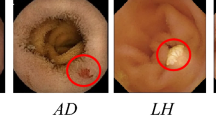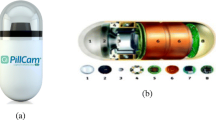Abstract
Wireless capsule endoscopy (WCE) is a device that can move through human body and capture the small bowel entirely. Thus, it is presented as an excellent diagnostic tool for evaluation of gastrointestinal diseases compared with traditional endoscopies. However, the diagnosis by the physicians is tedious since it requires reviewing the video extracted from the capsule and analysing all of its frames. This tedious task has fuelled the efforts of researchers to provide automated diagnostic techniques for WCE frameworks to detect symptoms of gastrointestinal illness. In this paper, a new computer-aided diagnosis method for abnormalities detection in WCE images is proposed. After a preprocessing step, we extract from these images the descriptor we feed to a kernel extreme learning machine to perform the classification process. The descriptor used in this work is a combination between the histogram of oriented gradients (HOG) that were extracted using the hue component of the HSV colour space, and a modified rotation-invariant local binary pattern. The proposed approach has been tested on different datasets, and the results obtained are satisfactory when compared to the state-of-the-art works.






Similar content being viewed by others
References
Bernal, J., Sánchez, F.J., Fernández-Esparrach, G., Gil, D., Rodríguez, C., Vilariño, F.: WM-DOVA maps for accurate polyp highlighting in colonoscopy: validation vs. saliency maps from physicians. Comput. Med. Imaging Graph 43, 99–111 (2015)
Charfi, S., El Ansari, M.: A locally based feature descriptor for abnormalities detection. Soft Comput. 24(6), 4469–4481 (2020)
Charisis, V.S., Katsimerou, C., Hadjileontiadis, L.J., Liatsos, C.N., Sergiadis, G.D.: Computer-aided capsule endoscopy images evaluation based on color rotation and texture features: an educational tool to physicians. In: Proceedings of the 26th IEEE International Symposium On Computer-Based Medical Systems, pp. 203–208. IEEE (2013)
Chollet, F.: Xception: Deep learning with depthwise separable convolutions. In: Proceedings of the IEEE conference on computer vision and pattern recognition, pp. 1251–1258 (2017)
Dalal, N., Triggs, B.: Histograms of oriented gradients for human detection. In: Computer Vision and Pattern Recognition, 2005. CVPR 2005. IEEE Computer Society Conference on, vol. 1, pp. 886–893. IEEE (2005)
Deeba, F., Bui, F.M., Wahid, K.A.: Computer-aided polyp detection based on image enhancement and saliency-based selection. Biomed. Signal Process. Control 55, 101530 (2020)
Deng, J., Dong, W., Socher, R., Li, L.J., Li, K., Fei-Fei, L.: Imagenet: a large-scale hierarchical image database. In: 2009 IEEE Conference on Computer Vision and Pattern Recognition, pp. 248–255. IEEE (2009)
El Jaafari, I., El Ansari, M., Koutti, L., Ellahyani, A., Charfi, S.: A novel approach for on-road vehicle detection and tracking. Int. J. Adv. Comput. Sci. Appl. 7(1), 594–601 (2016)
Ellahyani, A., El Ansari, M.: Mean shift and log-polar transform for road sign detection. Multimed. Tools Appl. 76(22), 24495–24513 (2017)
Ellahyani, A., El Ansari, M., El Jaafari, I.: Traffic sign detection and recognition based on random forests. Appl. Soft Comput. 46, 805–815 (2016)
Fan, S., Xu, L., Fan, Y., Wei, K., Li, L.: Computer-aided detection of small intestinal ulcer and erosion in wireless capsule endoscopy images. Phys. Med. Biol. 63(16), 165001 (2018)
He, K., Zhang, X., Ren, S., Sun, J.: Deep residual learning for image recognition. In: Proceedings of the IEEE Conference on Computer Vision and Pattern Recognition, pp. 770–778 (2016)
Huang, G.B., Zhou, H., Ding, X., Zhang, R.: Extreme learning machine for regression and multiclass classification. IEEE Trans. Syst., Man, Cybern., Part B (Cybern.) 42(2), 513–529 (2011)
Kopelman, Y., Gal, O., Jacob, H., Siersema, P., Cohen, A., et al.: Automated polyp detection system in colonoscopy using deep learning and image processing techniques. J. Gastroenterol. Compl. 3(1), 101 (2019)
Ojala, T., Pietikäinen, M., Harwood, D.: A comparative study of texture measures with classification based on featured distributions. Pattern Recogn. 29(1), 51–59 (1996)
Öztürk, Ş.: Stacked auto-encoder based tagging with deep features for content-based medical image retrieval. Expert Syst. Appl. 161, 113693 (2020)
Öztürk, Ş., Akdemir, B.: Real-time product quality control system using optimized Gabor filter bank. Int. J. Adv. Manuf. Technol. 96(1–4), 11–19 (2018)
Öztürk, Ş., Bayram, A.: Comparison of HOG, MSER, SIFT, FAST, LBP and CANNY features for cell detection in histopathological images. HELIX 8(3), 3321–3325 (2018)
Park, S., Lee, M., Kwak, N.: Polyp detection in colonoscopy videos using deeply-learned hierarchical features. Seoul National University (2015). https://mipal.snu.ac.kr/images/0/0b/Polyp_short_report.pdf
Qadir, H.A., Balasingham, I., Solhusvik, J., Bergsland, J., Aabakken, L., Shin, Y.: Improving automatic polyp detection using CNN by exploiting temporal dependency in colonoscopy video. IEEE J. Biomed. Health Inf. 24(1), 180–193 (2019)
Simonyan, K., Zisserman, A.: Very deep convolutional networks for large-scale image recognition. Sep. 4, 2014. ArXiv preprint arXiv:1409.1556 (2019)
Souaidi, M., Abdelouahed, A.A., El Ansari, M.: Multi-scale completed local binary patterns for ulcer detection in wireless capsule endoscopy images. Multimed. Tools Appl. 78(10), 13091–13108 (2019)
Wittenberg, T., Zobel, P., Rathke, M., Mühldorfer, S.: Computer aided detection of polyps in whitelight-colonoscopy images using deep neural networks. Curr. Dir. Biomed. Eng. 5(1), 231–234 (2019)
Yu, L., Yuen, P.C., Lai, J.: Ulcer detection in wireless capsule endoscopy images. In: Proceedings of the 21st International Conference on Pattern Recognition (ICPR2012), pp. 45–48. IEEE (2012)
Yuan, Y., Wang, J., Li, B., Meng, M.Q.H.: Saliency based ulcer detection for wireless capsule endoscopy diagnosis. IEEE Trans. Med. Imaging 34(10), 2046–2057 (2015)
Author information
Authors and Affiliations
Corresponding author
Additional information
Publisher's Note
Springer Nature remains neutral with regard to jurisdictional claims in published maps and institutional affiliations.
Rights and permissions
About this article
Cite this article
Ellahyani, A., Jaafari, I.E., Charfi, S. et al. Detection of abnormalities in wireless capsule endoscopy based on extreme learning machine. SIViP 15, 877–884 (2021). https://doi.org/10.1007/s11760-020-01809-x
Received:
Revised:
Accepted:
Published:
Issue Date:
DOI: https://doi.org/10.1007/s11760-020-01809-x




